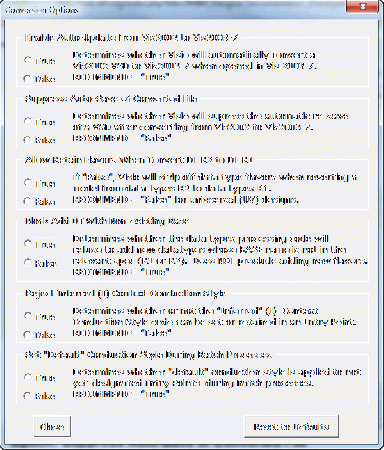RMIMDesDocConversionOptions
This page is a template that shows the Visio Conversion Options that appears in two places in the documentation
Contents
- 1 Conversion Options
- 1.1 Option: Enable Auto-Update from Vis2002 to Vis2003-7
- 1.2 Option: Suppress Auto-Save of Converted File
- 1.3 Option: Allow Retain Flavors When Convert DT R2 to DT R1
- 1.4 Option: Block Add DT With Non-existing Base
- 1.5 Option: Reject Inferred (I) Context Conduction Style
- 1.6 Option: Set "Default" Conduction Style During Batch Processes
Conversion Options
With the combination of data types releases and different Visio versions, as well as the addition of new code to document context conduction style for a model, there arose the need for somewhat greater control over the various conversion options. To this end, starting in release 4.5.1 (and extended in 4.6.6), a new menu item was added to the "HL7 menu" as Menu...HL7...Show Conversion Options to display a pane of such options. The pane appears like:
This (crude) pane contains true/false selections for five different conversion options. Each option has summary documentation on the pane itself, although somewhat more detail is provided below.
As they are changed, options are "saved" in the Hl7Visio.ini file in the HL7 shapes directory. The Close: button simply hides the options pane. The Reset to Defaults button will reset the five options to the values shown as "recommend" on the pane itself.
The first two of these options affect the process of upgrading designs from Visio 2002 to Visio 2003/7 and reverting them back to Visio 2002. (See Visio2002/2003-7 tab.)
The next two affect converting models between data types release R1 and release R2 (and vice-versa). (See DataTypeReleases tab.)
The final option disallows a value of "inferred (I)" as a context conduction style. Disallowing this option provides an easy way to detect all models for which an expressed method of context conduction has not been declared. (See 2010/11 Updates tab.)
Option: Enable Auto-Update from Vis2002 to Vis2003-7
As noted in the pane, determines whether Visio will automatically convert a "vsd" drawing file from Visio 2002 format to Vis2003-7 format when it is opened in Vis 2003-7. This update is necessary to cause the shapes to display correctly. A number of shapes, particularly the "arrow" classes appear to lose content when first viewed in Visio 2003-7
RECOMMEND = "True"
Option: Suppress Auto-Save of Converted File
As noted in the pane, Determines whether Visio will supress the automatic re-save of a VSD drawing after converting from Vis2002 to Vis2003-7. The automatic save, and a subsequent automatic re-open are part of the normal conversion process. Without these two steps, the shape representation does not "refresh" to a correct presentation. However, the save precludes being able to review designs from a read-only repository. For cases such as this, this opetion can be set "true".
RECOMMEND = "False"
Option: Allow Retain Flavors When Convert DT R2 to DT R1
As noted in the pane, if this option is "False", Visio will strip off data type flavors when reverting a model from data types R2 to data types R1. This is the preferred action for Universal ("UV") models, because data type flavors are usually added at the realm-specific level (or lower) rather than as part of universal designs.
RECOMMEND = "False" for universal (UV) designs.
Option: Block Add DT With Non-existing Base
As noted in the pane, Determines whether the data types processing code will refuse to add new data types whose "base" name is not in the relevant specification (R1 or R2). This does not preclude adding new flavors.
RECOMMEND = "True"
Option: Reject Inferred (I) Context Conduction Style
As noted in the pane, this option determines whether or not the "inferred (I)" context conduction style code can be set or retained in the entry point for a model. The methodology calls for one of three code values:
- "C" designates the model uses the original conduction-indicator-based method of establishing context conduction, a method that was deprecated during 2010.
- "V" designates the model uses the new vocabulary-based method of establishing context conduction as adopted during 2010.
- "I" designates that the model does not explicitly establish context conduction. This designation is formally "discouraged."
As models evolve, many of them (particularly those developed before 2010) are using the "inferred (I)" designation. While there is an easy way to establish context conduction style, changing the designation once made is cumbersome. Switching this option from "false" to "true" will cause the RMIM Designer logic to automatically seek user approval to change the designation code for any model designated as "inferred."
The final option disallows a value of "inferred (I)" as a context conduction style. Disallowing this option provides an easy way to detect all models for which an expressed method of context conduction has not been declared. (See 2010/11 Updates tab.)
RECOMMEND = "False" for routine use.
Option: Set "Default" Conduction Style During Batch Processes
When a model for which context conduction style has not yet been defined is processed with one of the batch options, this option determines whether or not the batch process should assert the "default" conduction style as it proceeds. Note, this setting will have no impact on the designs if the batch process is not also "saving" the files. Processes that do not save files include "validation" and "graphic overlay extraction"; processes that do save files include "conversions to different Visio releases", "data types conversions" and "scan, update and save vocabulary constraints while doing graphic overlay extraction."
RECOMMEND = "True"
